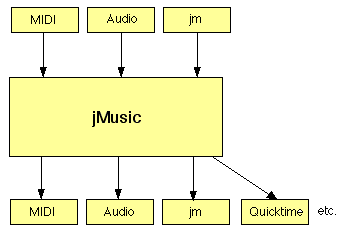Some jMusic BasicsjMusic works in non real time . What, I hear you say, non real time, what's the point then? Well, we could begin by giving you a summation of composition over the centuries and all the non real time work that has been completed before now, but suffice it to say that non real time has had a successful run of it up until now, and there is still a train of thought that says that non real time has benefits that outweigh its disadvantages. What this means to you is that you will not be able to hear what you have written until you have completed a program that generates it. The it in this instance is a SMF (standard MIDI file - remember, we won't remind you again) or audio file. All jMusic programs have the option of saving their output to a SMF or .au audio. This means that once your program that is designed to write top 10 pop tunes or the next Ars Electronica winner is complete, all you need to do is run the program and a great new piece will appear in your current directory as SpiceGirls.mid (or whatever you choose to call the file). Getting to and froWhile jMusic has been designed as a useful compositional environment to be in, it does not try to do everything but rather to integrate with your other computer music tools such as MIDI sequencers and audio editors. To hear your compositions you need to output jMusic scores to MIDI or Audio, and it can also be useful (but not necessary) to bring existing MIDI or audio files into jMusic as source material. jMusic scores interface with other music data formats, but exists autonomously from them, as shown in this diagram.  Composing processNow, how to write a program that produces top 10 pop songs - hmmm if only we knew. However, regardless of whether we aim for a top ten or not, this is the basic process behind non real time computer music composition.
Simple. If this makes complete sense to you then you have more than likely done some computer composition before. Otherwise you may like to check out some more authoritative ideas about the subject of computer music composition in some of our recommended readings. Now lets get to work. |
|
|
|
|
|
A quick and nasty guide to jMusic. |
|
Music, Composition, and the Computer |